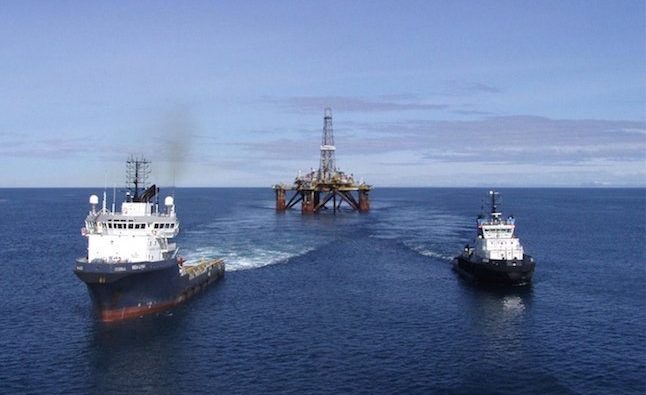OSVs brace for harsher 2017

Hold on to your hats, batten down the hatches, reach for whatever stormy, depressing metaphor you can as today Splash chief correspondent Jason Jiang warns those in the OSV sector this year is shaping up to be worse that the shocker that was 2016. The only silver lining from the range of analysts contacted for this report is that we are approaching the nadir of the current cycle.
Oversupply will continue to wreak havoc this year with cold-stacked vessels set to hit a new record this year while demand remains anaemic.
In a recently published report, Fearnley Offshore has forecast that the OSV sector will only get worse during 2017. Last year was the worst year on record for the battered sector since the mid-1980s.
“More or less all OSV owners are going through some form of restructuring/forced marriage/refinancing/bankruptcy/cutbacks/lay-off, or whatever description one might want to use. The reality of the situation is that the debt structure for most of these companies is almost impossible to handle as it stands,” Fernley Offshore said in the report.
“For owners and operators of OSVs and AHTSs, the oversupply is evident as we see the highest number of cold-stacked vessels on record,” says Lailah Soon, regional business development manager of GAC Asia Pacific.
Charter rates remain dire and contract terms tend to be shorter and shorter.
Soon reckons it will take until 2020 for OSV operators to get back on their feet again.
Todd Hornbeck, CEO of Hornbeck Offshore, reckons market sentiment and misplaced hope brought on by improved commodity prices will not fix the structural oversupply of vessels during the current depressed market.
“The facts are that as bad as 2016 was, 2017 will likely even be worse,” Hornbeck warns.
Hornbeck says current conditions in the market will drive change that can only be accomplished by the restructuring of the more financially distressed players, or more likely, the acquisition of the weaker players, or perhaps some of the more attractive assets by the stronger industry players.
“Restructurings come at an extremely high cost to the current stakeholders of restructuring entities. In addition, post reorganisation, such entities will pay a higher cost of capital. That is rarely a recipe for success in capital-intensive businesses, even one that is restructured,” Hornbeck points out.
Hornbeck believes more stacking wouldn’t help too much in yielding any form of recovery.
“Stacking has its own costs as fewer operating vessels shoulder the burden of the fixed cost of their owners, not to mention the attendant risk upon reactivation, including the potential permanent loss of highly strategic human capital,” says Hornbeck.
Stefano Cao, CEO of Saipem, says the decision by OPEC in November to reduce its quota has started to stabilise oil prices. However, this has yet to change the prevailing market conditions for the offshore industry.
Cao expects the low level of investment activity in the sector to persist in 2017 with the exceptions being growing demand in North America and the slight pickup in activity in the Middle East.
“In the longer term, the outlook will gradually improve, as the impact of the years of low investment in new projects makes itself felt through a shortfall in supply, spurring a new wave of investments,” Cao says.
Suvro Sarkar, an equity research analyst at Singapore’s DBS Bank, is more cautiously optimistic than others surveyed for this report.
“The inflexion point to watch for with regards to OSV players would be a positive reversal in capex budgets for global and national oil companies in 2017 in response to a more stable oil price environment,” says Sarkar.
The early signs have been good so far in 2017, he says, with a couple of oil majors like Exxon and CNOOC revising up 2017 capex plans. However, this will take time to filter through in terms of contracts for OSV players.
“We expect to see any meaningful earnings recovery only towards late 2017/ early 2018 timeframe. We believe OSV utilisation levels should improve through 2017, but day rates are likely to remain depressed owing to cutthroat competition,” Sakar maintains.
Sarkar believes OSV fleets which have more exposure to production activities – accommodation and maintenance vessels for example, have longer-term contract coverage, and higher exposure to national oil companies will continue to do better than the commoditised AHTS and PSV fleets, and a presence in select geographical markets such as the Middle East, West Africa, Brazil and Mexico is likely to be beneficial.
David Palmer, CEO of Pareto Securities, belives the recession in the offshore market is creating a real opportunity to change the way the industry is organised.
“We are all bored of hearing the doom and gloom and it’s time we all searched for signs of reversal,” Palmer says.
In Palmer’s opinion, there is a growing view that things have stopped getting worse.
“Vulture investors seeking debt deals are being left on sidelines as industrial players snap up real bargain tonnage and the gap between buyers and sellers narrows. M&A activity and consolidation is starting to build with several platforms that can be developed. Geography and capabilities are the key qualities sought,” Palmer insists.
Palmer sees a distinct improvement in utilisation in the seismic and anchor handling tug market with the construction companies benefiting from now necessary IRM work, while offshore rig utilisation has switched from declining to stable with rig owners reporting increased enquiry.
“Banks in Europe are being more practical than in Asia and do seem prepared to swap debt and forward interest and principal into equity provided equity and bond holders equally take some pain. This market is now moving from being brutally tough to one of building optimism,” Palmer concludes.
